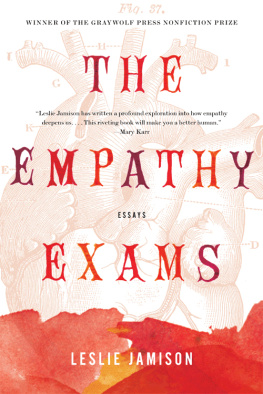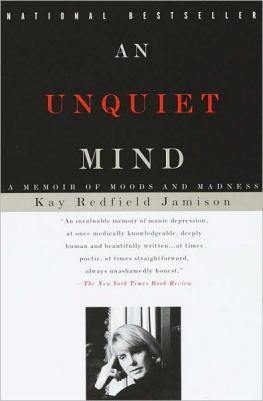
Copyright 2019 by Leslie Jamison
Cover design by Gregg Kulick
Author photograph by Beowulf Sheehan
Hachette Book Group supports the right to free expression and the value of copyright. The purpose of copyright is to encourage writers and artists to produce the creative works that enrich our culture.
The scanning, uploading, and distribution of this book without permission is a theft of the authors intellectual property. If you would like permission to use material from the book (other than for review purposes), please contact permissions@hbgusa.com. Thank you for your support of the authors rights.
Little, Brown and Company
Hachette Book Group
1290 Avenue of the Americas, New York, NY 10104
littlebrown.com
facebook.com/littlebrownandcompany
twitter.com/littlebrown
First ebook edition: September 2019
Little, Brown and Company is a division of Hachette Book Group, Inc. The Little, Brown name and logo are trademarks of Hachette Book Group, Inc.
The publisher is not responsible for websites (or their content) that are not owned by the publisher.
The Hachette Speakers Bureau provides a wide range of authors for speaking events. To find out more, go to hachettespeakersbureau.com or call (866) 376-6591.
The essays in this book previously appeared, sometimes in significantly different form, in the following publications: Up in Jaffna (as The Two Faces of Paradise) in Afar; 52 Blue in The Atavist; The Quickening and Sim Life in The Atlantic; Layover Story (as Baggage Claims) and We Tell Ourselves Stories in Order to Live Again (as Giving up the Ghost) in Harpers; No Tongue Can Tell in the Los Angeles Review of Books; The Long Trick (as Saudades) in the Mississippi Review; Rehearsals in The Nervous Breakdown; Daughter of a Ghost (as In the Shadow of a Fairy Tale) in the New York Times Magazine; Make It Scream, Make It Burn in the Oxford American; and Maximum Exposure (as Going Back) and Museum of Broken Hearts (as The Breakup Museum) in the Virginia Quarterly Review.
ISBN 978-0-316-25966-8
E3-20190815-DA-NF-ORI
For my father,
Dean Tecumseh Jamison
Explore book giveaways, sneak peeks, deals, and more.
Tap here to learn more.

When do our senses know any thing so utterly as when we lack it?
Marilynne Robinson, Housekeeping
D ecember 7, 1992. Whidbey Island, Puget Sound. The world wars were over. The other wars were over: Korea, Vietnam. The Cold War was finally over, too. The Whidbey Island Naval Air Station remained. So did the Pacific, its waters vast and fathomless beyond an airfield named for an airman whose body was never found: William Ault, who died in the Battle of the Coral Sea. This is how it goes. The ocean swallows human bodies whole and makes them immortal. William Ault became a runway that sends other men into the sky.
At the Naval Air Station, the infinite Pacific appeared as finite data gathered by a network of hydrophones spread along the ocean floor. Initially used to monitor Soviet subs during the Cold War, these hydrophones had since been turned toward the sea itself, transforming its formless noises into something measurable: pages of printed graphs rolling out of a spectrograph machine.
On that particular December day in 1992, petty officer second class Velma Ronquille heard a strange sound. She stretched it out on a different spectrogram so she could see it better. She couldnt quite believe that it was coming in at 52 hertz. She beckoned one of the audio technicians. He needed to come back, she said. He needed to take another look. The technician came back. He took another look. His name was Joe George. Velma told him, I think this is a whale.
Joe thought, Holy cow. It hardly seemed possible. The sound pattern looked like the call of a blue whale, but blue whales usually came in somewhere between 15 and 20 hertzan almost imperceptible rumble, on the periphery of what the human ear can detect. Fifty-two hertz was off the charts. But here it was, right in front of them, the audio signature of a creature moving through Pacific waters with a singularly high-pitched song.
Whales make calls for a number of reasons: to navigate, to find food, to communicate with one another. For certain whales, including humpbacks and blues, songs also play a role in sexual selection. Blue males sing louder than females, and the volume of their singingat more than 180 decibelsmakes them the loudest animals in the world. They click and grunt and trill and hum and moan. They sound like foghorns. Their calls can travel thousands of miles through the ocean.
Because this whales frequency was unprecedented, the folks at Whidbey kept tracking him for years, every migration season, as he made his way south from Alaska to Mexico. They figured it was a he, as only males sing during mating season. His path wasnt unusual, only his songalong with the fact that they never detected any other whales around him. He always seemed to be alone. This whale was calling out high, and apparently to no oneor at least, no one seemed to be answering. The acoustic technicians called him 52 Blue. A scientific report would eventually acknowledge that no other whale calls with similar characteristics had ever been reported. It is perhaps difficult to accept, the report conceded, that there could have been only one of this kind in this large oceanic expanse.
T he drive from Seattle to Whidbey Island took me through the plainspoken pageantry of Washington State industry: massive stacks of cut lumber, rivers clogged with tree trunks like fish trapped in pens, towers of candy-colored shipping containers near Skagit port, and a collection of dirty white silos near Deception Pass Bridge, its steel span looming majestically over Puget Soundhard-sparkling water glinting with shards of sunlight nearly two hundred feet below. On the far side of the bridge, the island felt pastoral and otherworldly, almost defensive. LITTER AND IT WILL HURT, one sign read. Another said, SPACE HEATERS NEED SPACE. Whidbey Island often calls itself the longest island in America, but this isnt strictly true. Whidbey is long, the Seattle Times observed in 2000, but lets not stretch it. Its long enough to hold a kite festival, a mussel festival, an annual bike race (the Tour de Whidbey), four inland lakes, and a yearly murder-mystery game that turns the entire town of Langley, population 1,035, into a crime scene.
Joe George, the technician who first identified 52 Blue, still lives in a modest hillside home perched on the northern end of Whidbey, about six miles from the air station. When I visited, he answered the door smilinga burly man with silver hair, no-nonsense but friendly. Though he hadnt worked at the air station for twenty years, he was still able to get us past security with his Navy ID. He told me he uses it whenever he comes back to the base to drop off his recycling. Outside the officers club, men in flight suits were drinking cocktails on a wooden deck. The coastline was ragged and beautiful beyondwaves crashing onto dark sand, salt wind moving through the evergreens.
Joe explained that when he worked at the air station, his teamthe team responsible for processing audio data from the hydrophoneswas fairly disconnected from the rest of the base. It was a question of security, he said. When we reached his old building, I saw what he meant. It was surrounded by double fences topped with razor wire. He told me that some of the other servicemen on base used to think his building was some kind of prison. They never knew what it was for. When I asked him what he had thought those strange sounds had been, back in 1992, before he realized they were whale calls, he said, I cant tell you that. Its classified.
Next page









